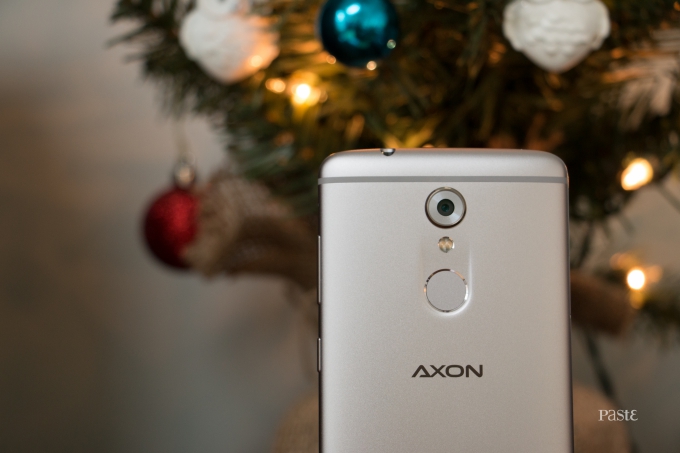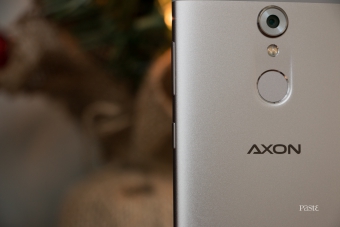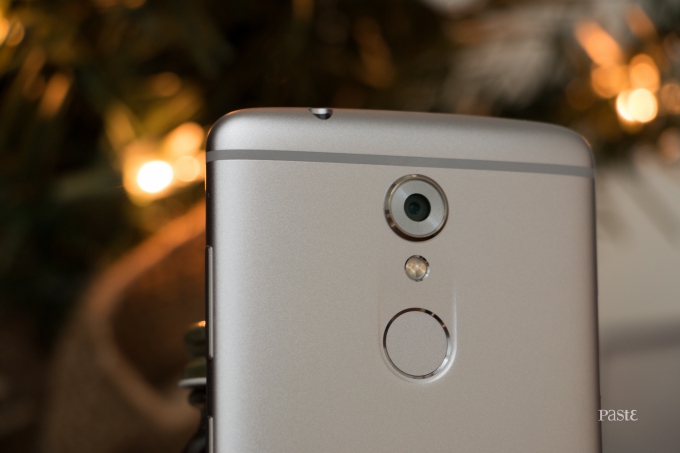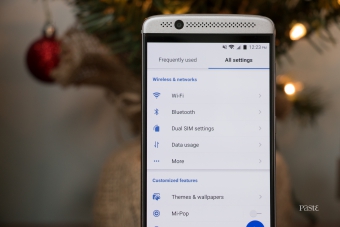
After spending the last few weeks with ZTE’s Axon 7 Mini, the lingering question I have is: who is this phone for?
The 7 Mini is another in a growing line a budget-conscious smartphones that have little in the way of sacrifices. At $300, it’s a good value, but it’s not the best value the company offers. That belongs to the device it’s based on, ZTE’s flagship Axon 7. For $400 (available for only $350 right now on the company’s website) you get a 5.5-inch QHD display, Snapdragon 820 processor, 4GB of RAM, a 3250 mAh battery and a 20MP camera capable of shooting 4K video.
The 7 Mini, on the other hand, offers far more midrange specifications. Inside its aluminum body is a Snapdragon 617 processor, 3GB of RAM, a 2705 mAh battery and a 16MP shooter capable of 1080P video capture. It’s rounded out by a 5.2-inch, 1080P AMOLED display.
For a difference of $50 or $100, why would a potential buyer choose the Mini over the standard 7? The easiest answer is the one right in the name. People who are drawn to the former want a smartphone that is easily used in one hand and will fit in most pockets. But this is not the Pixel and Pixel XL, where the difference in screen size is almost a full inch. Here, it is a measly three-tenths of an inch. As someone with hands on the smaller size, I can say this is not the easiest device to use with a single hand. There is still a degree of palm gymnastics that must occur in order to reach the corners.
Price nor size make the it a smarter buy than the standard model. The Mini asks you to live with inferior specs over trivial differences, which brings me back to my initial question.
Who is this phone for?
 I cannot deny that ZTE has done a marvelous job with the hardware here. Budget-conscious devices have gotten much better in recent years from a hardware perspective, but the Mini is a cut above the rest.
I cannot deny that ZTE has done a marvelous job with the hardware here. Budget-conscious devices have gotten much better in recent years from a hardware perspective, but the Mini is a cut above the rest.
It not only offers a great fit and finish for its price range, it stands up against the very best phones on the market from a hardware perspective. Others in this category, like the Huawei Honor 5X I used early this year, don’t hold up as well when you stack them against premium flagships.
I lauded the 5X for its hardware, and stick by my initial assessment that it’s a well-built machine most people would fail to notice was just $199 at first glance. But the minute you put it up against a phone two or three times its price, you could feel the difference in quality, from the raw materials to overall construction.
 The Axon 7 Mini does not suffer the same fate. It is a rock solid handset, that looks just as good next to a device like the Honor 5X as it does the Pixel XL. It feels phenomenal in the hand, comfortable to use for long stretches thanks to its curved back, and has a fantastic fit and finish. The phone feels as though it could take a few nasty spills, or even be used in place of a proper puck in a pond hockey game, and make it through minimally scathed.
The Axon 7 Mini does not suffer the same fate. It is a rock solid handset, that looks just as good next to a device like the Honor 5X as it does the Pixel XL. It feels phenomenal in the hand, comfortable to use for long stretches thanks to its curved back, and has a fantastic fit and finish. The phone feels as though it could take a few nasty spills, or even be used in place of a proper puck in a pond hockey game, and make it through minimally scathed.
The front-facing dual speakers are a nice feature, though they aren’t the best I’ve heard in 2016. Still, so few OEMs put emphasis on sound these days that ZTE deserves a pat on the back for even including them in the first place.
 The biggest fault I have with the hardware is the fingerprint scanner. A veritable necessity in 2016, no matter the price, the Axon 7 Mini does get points for offering a fingerprint reader, but the one here is far from best-in-class. Throughout my few weeks testing the device, it rejected my fingerprint more often than I’d like, and usually when my fingertip was in perfect position, not a glancing swipe.
The biggest fault I have with the hardware is the fingerprint scanner. A veritable necessity in 2016, no matter the price, the Axon 7 Mini does get points for offering a fingerprint reader, but the one here is far from best-in-class. Throughout my few weeks testing the device, it rejected my fingerprint more often than I’d like, and usually when my fingertip was in perfect position, not a glancing swipe.
When it does work, the phone can take a second or two to unlock. It’s not the most egregious flaw in the world, but it was enough to annoy me over the course of my review period. If you rely on Android Pay, or value the convenience of a quick fingerprint scanner, I’d be wary.
Beyond that, there is very little to complain about from a hardware perspective. Though it is a downgrade from the standard’s QHD resolution, the 5.2-inch, 1080P screen here is fine for any user. If you stack it against some of the better panels in the business, there’s a clear separation in quality, particularly with color vibrancy, but most users won’t do that. On its own, it holds up well whether you’re just browsing Reddit, watching a movie or playing a game.
Great hardware isn’t enough to stand out in the budget-conscious market, or even the premium market, however. While I admit ZTE has done a fantastic job with the build quality, my initial question still hasn’t been answered. There needs to be more beyond a great design, which most consumers will cover with a case, and fabulous build quality.
 That leaves the software and camera to try and bring home the argument that the 7 Mini is worth serious consideration if you’re in the market for a new phone. Unfortunately, neither of those aspects are up to the task.
That leaves the software and camera to try and bring home the argument that the 7 Mini is worth serious consideration if you’re in the market for a new phone. Unfortunately, neither of those aspects are up to the task.
The software at work here reminds me of a combination of LG’s Android skin and TouchWiz. That means it’s not the most aesthetically pleasing, but in the end it gets the job done. I can look past a bit of ugly software, though I personally would not want to have to look at ZTE’s MiFavor UI for two years of my life, but what really concerns me is performance.
As I mentioned at the outset, the handset comes packing a Snapdragon 617 processor and 3GB of RAM. Both of those should combine to offer a snappy experience. I mentioned in my initial impressions that the stuttery nature of its performance had me concerned. I also mentioned that I thought the Mini was being dealt an unfair hand as the smartphone I used directly after reviewing the Pixel XL, perhaps the best performing Android device of all time.
 In the end, both of those statements rang true to a degree. The smartphone was overshadowed at first impression by the Pixel XL, but it also suffers from nagging performance issues on occasion. Nothing outrageous, but if you are seriously considering this handset you have to do so knowing it will not always be a fluid experience.
In the end, both of those statements rang true to a degree. The smartphone was overshadowed at first impression by the Pixel XL, but it also suffers from nagging performance issues on occasion. Nothing outrageous, but if you are seriously considering this handset you have to do so knowing it will not always be a fluid experience.
There’s a jittery quality to using it in an everyday setting, not so slow that you want to throw it at a wall but it always seems to be one step behind where you’d like it. I imagine if I were to give it even more time (and distance from the Pixel) I would eventually settle into a rhythm with it, but as it stands, I fear what the device would look like two years from now.
I can’t imagine myself, or anyone really, putting up $300 for a phone they’re not sure performs well enough on day one, let alone in two years, when they could spend an extra hundred dollars for something far more future-proof thanks to its top-of-the-line internals. If you’re a light user and don’t do much gaming, the Mini should get you by for a few years. Kick things up an extra gear and my confidence in how well this phone will hold up wanes considerably. Right now, fresh out of the box, it handles most everything fine, if noticeably slower than a more expensive handset.
 For comparison’s sake, I dug out the now year-old OnePlus X, another highly recommended budget phone, to see how its experience in terms of performance stacked up against the 7 Mini. The X initially sold for $249, $50 cheaper than ZTE’s 2016 offering, with a Snapdragon 801 chip and 3GB of RAM inside.
For comparison’s sake, I dug out the now year-old OnePlus X, another highly recommended budget phone, to see how its experience in terms of performance stacked up against the 7 Mini. The X initially sold for $249, $50 cheaper than ZTE’s 2016 offering, with a Snapdragon 801 chip and 3GB of RAM inside.
The 801 was the top-tier processor of 2014, the chip you would have found on-board the Galaxy S5, HTC One M8, LG G3 and others. It was made to do serious labor, but was also a year old when the OnePlus X launched, and is now two-years-old. The 617, by contrast, is a newer processor but lacks some of the qualities of the 801, like 4K video support. Any way you shake it, the two are pretty evenly matched from a pure technical perspective, but the experience of using the OnePlus X felt remarkably smoother.
Part of the issue must be software optimization, and there are certain animations built into the MiFavor UI that make it feel slower than it should. Either way, the performance concerns are very real, and it makes this a tougher sell when there’s a ZTE device on the market packing a Snapdragon 820.
 The camera is likewise unimpressive. It’s not bad, per se, it just won’t wow anyone. In good lighting, and I do mean good lighting, the 20 MP rear-shooter is able to deliver decent photos with natural colors and a fair amount of detail. There is issue with dynamic range, highlights in bright lighting are easily blown out, but otherwise the camera offers photos that are fine to be shared on social media. Scrutinize them any further than that, and they don’t hold up well. If you delve into a photo like the one above you can see how soft the image is, especially in the shadowed portion.
The camera is likewise unimpressive. It’s not bad, per se, it just won’t wow anyone. In good lighting, and I do mean good lighting, the 20 MP rear-shooter is able to deliver decent photos with natural colors and a fair amount of detail. There is issue with dynamic range, highlights in bright lighting are easily blown out, but otherwise the camera offers photos that are fine to be shared on social media. Scrutinize them any further than that, and they don’t hold up well. If you delve into a photo like the one above you can see how soft the image is, especially in the shadowed portion.
“Shadowed portion” is an important distinction because it highlights the biggest fault of this camera. Take away any shred of light and the degradation of quality is clear and obvious. The camera does not handle low light well and even tends to snap into its “Night Mode” feature fairly often in what I would consider a well-lit room. Once light becomes scarce, so does detail in the photos, colors become flat and the overall quality takes a serious hit.
 On top of that, the camera app isn’t a joy to use. It does offer a bevy of nice features, including a manual mode, but it’s sluggish and there is definite shutter lag at play. Something as simple as switching between photo and video modes causes noticeable hesitation. That makes a lot of the cameras features moot.
On top of that, the camera app isn’t a joy to use. It does offer a bevy of nice features, including a manual mode, but it’s sluggish and there is definite shutter lag at play. Something as simple as switching between photo and video modes causes noticeable hesitation. That makes a lot of the cameras features moot.
I wouldn’t feel comfortable using the manual mode, where controls are cumbersome on a touch interface and therefore require responsive software and a skilled user to ensure the desired shot is captured, given the slowdowns suffered in auto mode and when simply trying to move about the interface. The 8MP front-facing selfie camera suffers a similar fate. It will take your photo well enough for Snapchat or Instagram, but you won’t be parading it around in service of its quality.
 Let’s address that initial question one last time.
Let’s address that initial question one last time.
Who is the Axon 7 Mini for?
I don’t know.
I can’t make a solid argument based on budget or size, given that the separation in those regards to the far more enticing Axon 7 is minimal. Even if you can’t stand large phones, I would still suggest you tough it out with the 5.5-inch 7 over it’s smaller counterpart so you get a device that should be able to withstand the pressures of two or more years of use.
Beyond not being able to figure out who this phone is for, I can’t even figure out why it exists. The idea of having two sizes makes absolute sense. That’s why numerous companies, including those at the top, offer their best flagships in variations. But this is not a variation on ZTE’s best. It’s a lesser version done up in the same outfit, with a reduced price.
At $200, the 7 Mini would be an intriguing buy. At that price, it would offer the best hardware and good enough performance for your money. Instead, at $300, it’s stuck in no man’s land. With the original Axon 7 currently at $350 (a price that ends 12/17), this isn’t the best value the company offers. Even at its standard price of $400, I would rather suggest someone pick up an extra shift or wait a few more weeks to save up the money to buy the standard 7.
If you have a hard budget of $300 or less, the Axon 7 Mini offers truly fantastic hardware, and chances are you’ll grow used to its performance. But if you have a bit of wiggle room, use it, and find a better value.